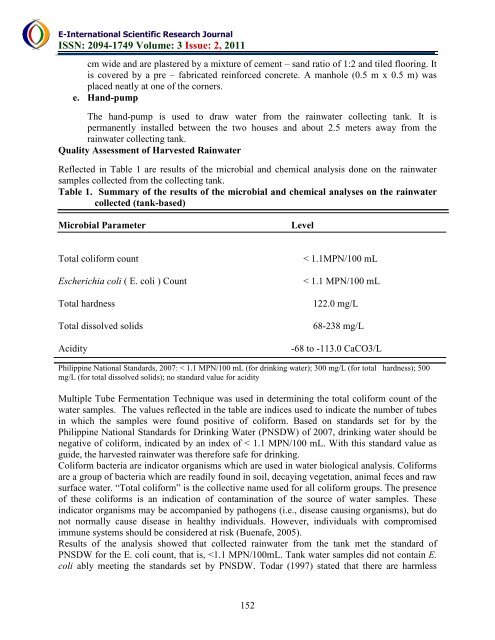download the full article here - E-International Scientific Research ...
download the full article here - E-International Scientific Research ...
download the full article here - E-International Scientific Research ...
You also want an ePaper? Increase the reach of your titles
YUMPU automatically turns print PDFs into web optimized ePapers that Google loves.
E-<strong>International</strong> <strong>Scientific</strong> <strong>Research</strong> Journal<br />
ISSN: 2094-1749 Volume: 3 Issue: 2, 2011<br />
cm wide and are plastered by a mixture of cement – sand ratio of 1:2 and tiled flooring. It<br />
is covered by a pre – fabricated reinforced concrete. A manhole (0.5 m x 0.5 m) was<br />
placed neatly at one of <strong>the</strong> corners.<br />
e. Hand-pump<br />
The hand-pump is used to draw water from <strong>the</strong> rainwater collecting tank. It is<br />
permanently installed between <strong>the</strong> two houses and about 2.5 meters away from <strong>the</strong><br />
rainwater collecting tank.<br />
Quality Assessment of Harvested Rainwater<br />
Reflected in Table 1 are results of <strong>the</strong> microbial and chemical analysis done on <strong>the</strong> rainwater<br />
samples collected from <strong>the</strong> collecting tank.<br />
Table 1. Summary of <strong>the</strong> results of <strong>the</strong> microbial and chemical analyses on <strong>the</strong> rainwater<br />
collected (tank-based)<br />
Microbial Parameter<br />
Level<br />
Total coliform count<br />
Escherichia coli ( E. coli ) Count<br />
Total hardness<br />
Total dissolved solids<br />
Acidity<br />
< 1.1MPN/100 mL<br />
< 1.1 MPN/100 mL<br />
122.0 mg/L<br />
68-238 mg/L<br />
-68 to -113.0 CaCO3/L<br />
Philippine National Standards, 2007: < 1.1 MPN/100 mL (for drinking water); 300 mg/L (for total hardness); 500<br />
mg/L (for total dissolved solids); no standard value for acidity<br />
Multiple Tube Fermentation Technique was used in determining <strong>the</strong> total coliform count of <strong>the</strong><br />
water samples. The values reflected in <strong>the</strong> table are indices used to indicate <strong>the</strong> number of tubes<br />
in which <strong>the</strong> samples were found positive of coliform. Based on standards set for by <strong>the</strong><br />
Philippine National Standards for Drinking Water (PNSDW) of 2007, drinking water should be<br />
negative of coliform, indicated by an index of < 1.1 MPN/100 mL. With this standard value as<br />
guide, <strong>the</strong> harvested rainwater was <strong>the</strong>refore safe for drinking.<br />
Coliform bacteria are indicator organisms which are used in water biological analysis. Coliforms<br />
are a group of bacteria which are readily found in soil, decaying vegetation, animal feces and raw<br />
surface water. “Total coliform” is <strong>the</strong> collective name used for all coliform groups. The presence<br />
of <strong>the</strong>se coliforms is an indication of contamination of <strong>the</strong> source of water samples. These<br />
indicator organisms may be accompanied by pathogens (i.e., disease causing organisms), but do<br />
not normally cause disease in healthy individuals. However, individuals with compromised<br />
immune systems should be considered at risk (Buenafe, 2005).<br />
Results of <strong>the</strong> analysis showed that collected rainwater from <strong>the</strong> tank met <strong>the</strong> standard of<br />
PNSDW for <strong>the</strong> E. coli count, that is,

















